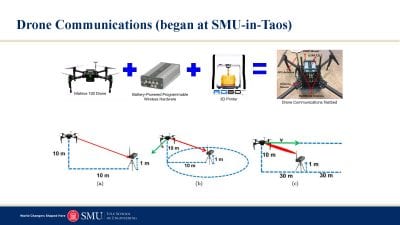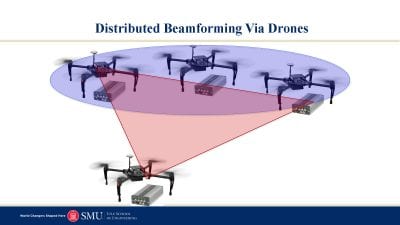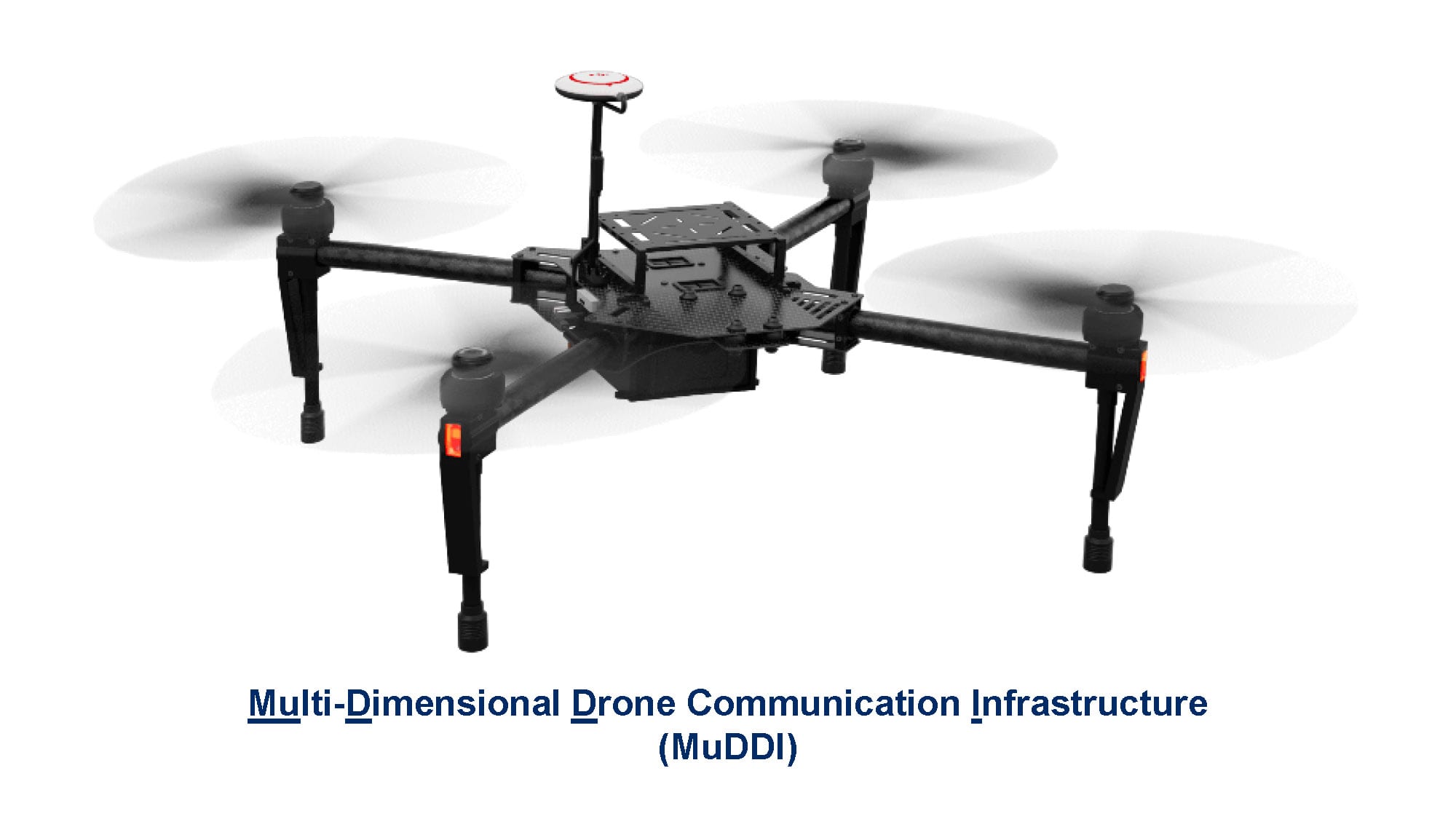DALLAS (SMU) – Faculty and students in SMU’s Lyle School of Engineering will use an $849,839 grant from the National Science Foundation to improve unmanned aerial vehicle (drone) communications, with the potential to enable the next wave of drone applications ranging from delivery of consumer goods to supporting autonomous combat and search and rescue efforts.
The award to Joseph Camp and Dinesh Rajan in the Electrical Engineering Department begins funding their work Oct. 1, 2018 and will extend through Sept. 30, 2021. The objective is to build infrastructure for Multi-Dimensional Drone Communications Infrastructure (MuDDI) to address research issues related to three-dimensional (3-D) connectivity, distributed antennas across a drone swarm and 3-D swarm formations that optimize the transmission to intended receivers.
MuDDI will allow the SMU team to rent and equip indoor space relatively close to campus for repeatable experimentation. “This will allow us to run our experiments in a controlled environment with the ability to precisely measure the wireless transmission characteristics,” Camp said.
The project will include:
- Building a programmable drone platform that can dynamically switch across multiple antennas with various positions and orientations on the drone that increase signal from a
 particular drone to direct transmissions across the extremes of physical dimensions.
particular drone to direct transmissions across the extremes of physical dimensions. - Experimental analysis of the various channel feedback mechanisms that have been identified but have yet to be evaluated on drones with in-flight vibrations and mobility patterns and various swarm formations.
- Constructing and incorporating large-scale antenna arrays over the surface of the ceiling and surrounding walls in the test facility to capture various multiple-input/multiple-output (MIMO) transmission patterns of a single drone seeking 3-D connectivity, distributed drone swarm creating various formations, and a massive-MIMO ground station.
- Integrating a massive-MIMO control station that can direct transmissions to, and track the mobility of, in-flight systems enabling research on the various beam widths and multi-user beam patterns that may be simultaneously allocated among large antenna arrays.
“When you start to think about drones, the communication issues are not 2D anymore – they are 3D,” Camp said. “When we built a drone platform at SMU in Taos last summer, we put the antennas on top of the drone so they wouldn’t interfere with landing gear. What we then found out was when the drone got to a certain height, it could only communicate from side-to-side, not directly below it.”
“When drones are required to talk to other drones, the communication, by definition, can be in any direction at any point in time,” Camp said. “We make the assumption that radios are expensive in terms of power, weight, and cost and that a switching mechanism from these radios to a greater number of antennas could significantly lower the resource consumption of a drone communications platform. In addition, if carefully designed, multiple drones could team to form a large antenna array to improve communication range.”
The research being directed by Camp and Rajan could have far-reaching applications for the future of UAV communications, including increasing Internet connectivity during natural disasters as well as commercial and military applications, all of which require coordination of multiple entities across various altitudes, from in-flight to ground-based stations. Potential applications also include deploying WiFi in underserved, low-income neighborhoods.
 A warehouse in close proximity to campus currently is being outfitted to the specific dimensions required for faculty and students to analyze data and applications for this project. In addition, interested students can join Camp each June at SMU’s campus in Taos, NM, where he teaches an “Introduction to Drone Communications” class where students learn the fundamentals of experimentation research for the purposes of
A warehouse in close proximity to campus currently is being outfitted to the specific dimensions required for faculty and students to analyze data and applications for this project. In addition, interested students can join Camp each June at SMU’s campus in Taos, NM, where he teaches an “Introduction to Drone Communications” class where students learn the fundamentals of experimentation research for the purposes of
design novel measurement studies for drone communications.
Camp is an Associate Professor of Electrical Engineering and Computer Science and Engineering in SMU’s Lyle School of Engineering. He joined the SMU faculty in 2009 after receiving his Ph.D. in ECE from Rice University. He received the National Science Foundation CAREER Award in 2012.
Rajan is Cecil and Ida Green Endowed Professor of Engineering. He has served as professor and chair of the Electrical Engineering Department in the Lyle School, and received an NSF CAREER Award in 2006. He joined SMU in 2002 and earned his Ph.D. in electrical and computer engineering from Rice University.
About SMU
SMU is a nationally ranked private university in Dallas founded 100 years ago. Today, SMU enrolls approximately 11,000 students who benefit from the academic opportunities and international reach of seven degree-granting schools.
About the Bobby B. Lyle School of Engineering
SMU’s Bobby B. Lyle School of Engineering, founded in 1925, is one of the oldest engineering schools in the Southwest. The school offers eight undergraduate and 29 graduate programs, including master’s and doctoral degrees, through the departments of Civil and Environmental Engineering; Computer Science and Engineering; Electrical Engineering; Engineering Management, Information, and Systems; and Mechanical Engineering. Lyle students participate in programs in the unique Deason Innovation Gym, providing the tools and space to work on immersion design projects and competitions to accelerate leadership development and the framework for innovation; the Hart Center for Engineering Leadership, helping students develop nontechnical skills to prepare them for leadership in diverse technical fields; the Caruth Institute for Engineering Education, developing new methodologies for incorporating engineering education into K-12 schools; and the Hunter and Stephanie Hunt Institute for Engineering and Humanity, combining technological innovation with business expertise to address global poverty.
